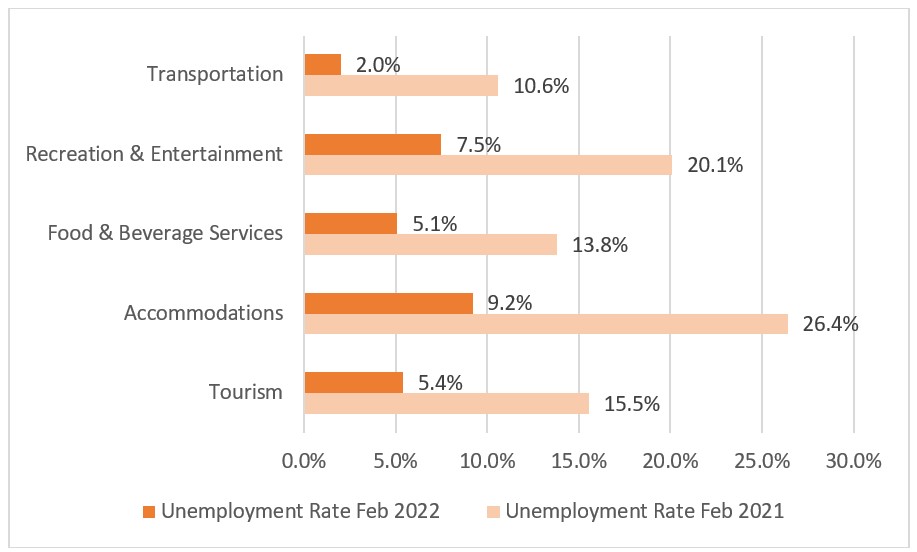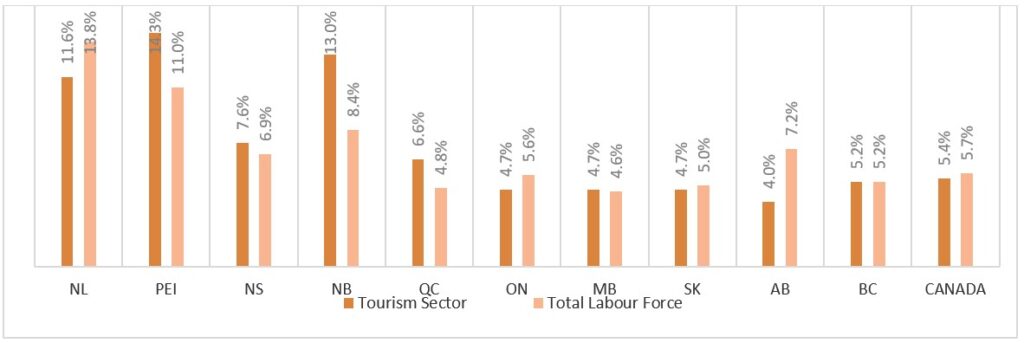Canadian Tourism Monthly Snapshot
Tourism added 188,700 jobs, unemployment rates fall but an overall labour force shortage remains
While declines in the size of the overall tourism labour force persist, tourism employees continued to return to work and find available employment opportunities this past month.
Seasonally unadjusted data released for February 2022 shows that, at 1,856,800 workers, Canada’s tourism labour force still falls short of the 2,152,000 workers that made up the industry pre-pandemic this same month in 2020.
While the unemployment rate in the tourism sector was at 5.4%—which is 10.1 percentage points lower than the rate reported in Feb 2021 (15.5%), and lower than the previous month (January 2022) when the unemployment rate stood at 11.9%—tourism continues to face an unprecedented labour shortage as public health measures to stem the COVID-19 Omicron variant remained in place in many provinces during what is already a typically low period of economic activity for the industry.
At 5.4%, tourism’s unemployment rate was slightly below Canada’s seasonally unadjusted unemployment rate of 5.7%, but higher than before the holiday season when the tourism unemployment rate stood at 5.2% for December 2021.
All tourism industry groups have reported lower unemployment rates than the same month last year.
Tourism Unemployment Rates by Industry Feb. 2021 vs. Feb. 2022 (seasonally unadjusted)
On a provincial basis, tourism unemployment rates ranged from 4.0% in Alberta to 14.3% in Prince Edward Island.
The seasonally unadjusted unemployment rates for tourism in each province, with the exceptions of Prince Edward Island, Nova Scotia, New Brunswick, Quebec, and Manitoba, were below the rates reported for the provincial economy.
Tourism Sector vs. Total Labour Force Unemployment Rates by Province (seasonally unadjusted)
Employment Numbers
Tourism employment comprised 9.1% of the total Canadian labour force for February 2022. Tourism employment increased by 188,700 (or 12%) from the previous month. Total employment now sits at 1,756,000 (up from 1,567,300 in January).
For the Canadian economy as a whole, seasonally unadjusted employment grew by 388,100.
The employment increases in both tourism and the broader economy were due to increases in part-time employment. Part-time employment in the tourism industry increased by 131,000 (or 21.2%), while full-time employment increased by 57,600 (or 6.1%).
Month-over-Month Employment Change, Full- and Part-Time Employment (seasonally unadjusted)
| Full-time employment change (x 1,000) | Part-time employment change (x 1,000) | |
| Tourism | 57.6 | 131 |
| Accommodations | 0 | 9.6 |
| Food and Beverage | 25.2 | 58.6 |
| Recreation and Entertainment | 38.5 | 49.8 |
| Transportation | -1.8 | 11.1 |
| Travel Services | -4.2 | 2 |
Looking Toward Spring 2022
It is typical for seasonally unadjusted employment indicators to show signs of volatility in the winter months; however, the first two months of 2022 brought positive signs that employees are returning to tourism occupations.
As the industry gears up for warmer weather and as restrictions are eased by several provincial governments in March, more than ever, local demand is going to be an important success factor for the tourism sector this spring.
For a full look at the tourism labour market and economic indicators, visit the Tourism Employment Tracker.
SOURCE: Statistics Canada Labour Force Survey, customized tabulations. Based on data for the week ending March 1, 2022.



